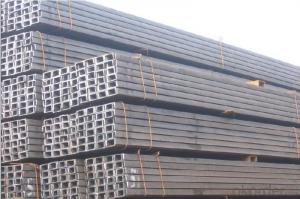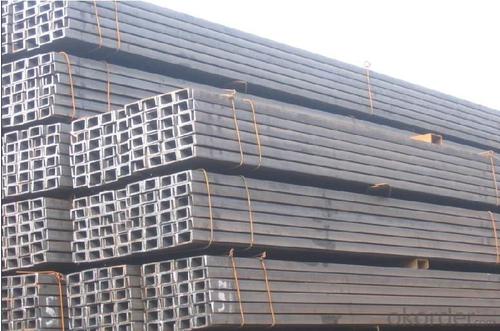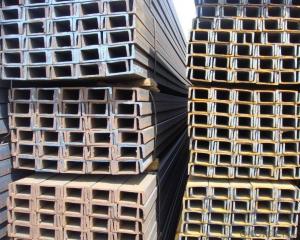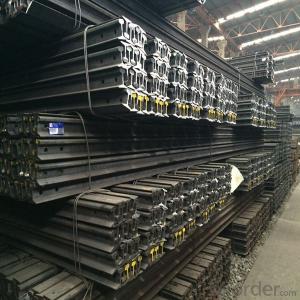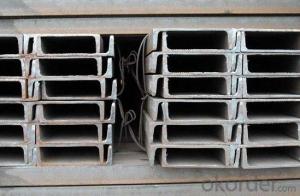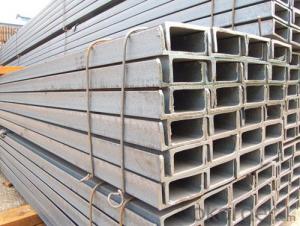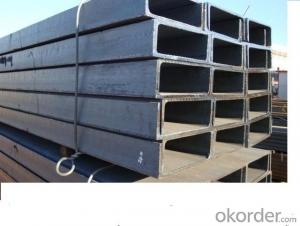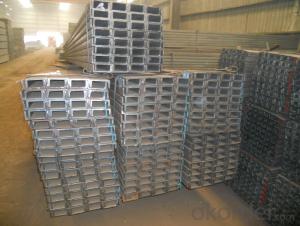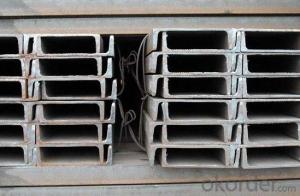GB Standard Steel Channel 50mm-62mm with High Quality
- Loading Port:
- China Main Port
- Payment Terms:
- TT or LC
- Min Order Qty:
- 25 m.t
- Supply Capability:
- 10000 m.t/month
OKorder Service Pledge
OKorder Financial Service
You Might Also Like
Product Description:
Specifications of GB Standard Steel Channel 50mm-62mm with High Quality:
We are definitely specializing in manufacturing and supplying channel steel.
| Standard: | GB/T 6723-86 |
| Sizes: | 50mm to 300mm |
| Sales Volume/Year: | 3000MT |
| Destination Area: | Middle EasAfrica, Southeast Asiat, |
2. Size, Length and Mass of GB Standard Steel Channel 50mm-62mm with High Quality.
| Size(mm) | Length(m) | Mass(Kg/m) |
50*25*2.5 mm | 6m, 12m | 1.444 kg/m |
| 62*44*1.6 mm | 6m, 12m | 1.796 kg/m |
Package & Delivery of GB Standard Steel Channel 50mm-62mm with High Quality:
The steel u channel will be packed in bundle with steel wire at each end of every bundle and color marking in order to help the customer to recognize his goods more easily at sight.
And steel u channel could be loaded into 20ft or 40ft container, or by bulk cargo. If the weight of each bundle reaches less than 3.5 mt, the loading by break bulk cargo should be choosed. When the weight of each bundle reaches less than 3mt, the loading by container should be choosed.
As for the transportaion from mill to loading port, the truck will be usually used. And the maximum quantity for each truck is 40mt.
All in all, we could do in accordance with customer's request.
FAQ:
Q1: How soon can we receive the product after purchasement?
A1: Within three days of placing an order, we will begin production. The specific shipping date is dependent upon international and government factors, but is typically one month.
Q2: How do you guarantee the quality of our products?
A2: We have established an advanced quality management system which conducts strict quality tests at every step, from raw materials to the final product. At the same time, we provide extensive follow-up service assurances as required.
Q3: The prices are invoicing on theoritical weight or on actual weight?
A3: We can do it in both manners, according to the customers' request.
Images of GB Standard Steel Channel 50mm-62mm with High Quality:

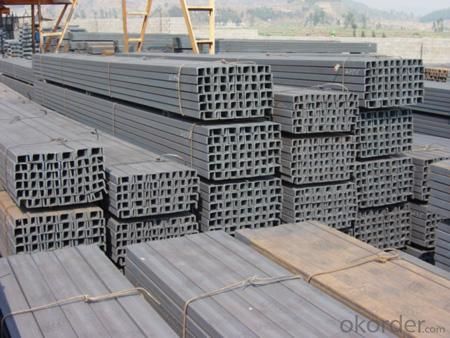
If you would like to get our price, please inform us the standard/material, size and quantity. Thank you very much.
- Q: What are the factors that affect the price of steel channels?
- The factors that affect the price of steel channels include the cost of raw materials, such as iron ore and coal, as well as production and transportation costs. Demand and supply dynamics, including global economic conditions and construction activity, also play a significant role in determining the price of steel channels. Additionally, external factors like government policies, trade regulations, and currency fluctuations can impact the cost of steel channels.
- Q: How do steel channels contribute to the overall safety of a structure during earthquakes?
- Steel channels play a crucial role in enhancing the overall safety of structures during earthquakes. One of the main reasons is their ability to provide structural stability and strength. Steel channels are typically used as components of the structural system to distribute and transfer loads. During an earthquake, these channels act as load-bearing members, effectively absorbing and dispersing the seismic forces to prevent localized damage. The shape and form of steel channels allow them to resist lateral forces and provide resistance against bending and twisting motions caused by seismic waves. By distributing the forces evenly throughout the structure, steel channels help in preventing concentrated stress points that could potentially lead to structural failure. Additionally, steel channels are highly durable and resistant to damage, making them ideal for earthquake-prone regions. Their high strength-to-weight ratio allows for the construction of lighter yet robust structures. This reduces the overall mass of the building, which in turn reduces the inertia forces generated during an earthquake and minimizes the likelihood of structural collapse. Furthermore, steel channels can be incorporated into seismic design strategies such as moment resisting frames or braced frames. These systems provide additional rigidity and stiffness to the structure, ensuring that it can withstand the lateral forces exerted by an earthquake. The flexibility of steel channels also allows for the absorption of energy, reducing the impact on the overall structure. In summary, steel channels contribute to the overall safety of a structure during earthquakes by providing structural stability, distributing seismic forces, resisting bending and twisting motions, and reducing mass and inertia forces. Their durability, strength, and ability to absorb energy make them a vital component in earthquake-resistant design strategies.
- Q: Are steel channels suitable for seismic retrofitting?
- Yes, steel channels are suitable for seismic retrofitting. Steel channels are commonly used in seismic retrofitting projects due to their high strength and ductility. They can be used to reinforce and strengthen existing structures, especially in areas with high seismic activity. Steel channels are able to absorb and distribute seismic forces, making them effective in improving the structural integrity and performance of the building during an earthquake. Additionally, steel channels can be easily installed and integrated into existing structures, making them a popular choice for seismic retrofitting projects. Overall, steel channels are a reliable and suitable option for seismic retrofitting.
- Q: What are the considerations for designing steel channel connections?
- When designing steel channel connections, several considerations need to be taken into account. First and foremost, the load requirements and forces acting on the connection must be carefully evaluated. This includes considering factors such as applied loads, moments, and shear forces. Additionally, the type of connection method, such as welding or bolting, should be chosen based on factors like the structural requirements, ease of installation, and potential for future modifications. The material properties of the steel channels must also be considered, including the strength, stiffness, and corrosion resistance. The design should ensure proper alignment and fit between the connected members to ensure load transfer and adequate support. It is also important to consider the potential for fatigue and stress concentrations, and incorporate measures to mitigate these issues, such as using fillets or chamfers. Overall, the design of steel channel connections should prioritize structural integrity, durability, and ease of construction, while adhering to relevant codes and standards.
- Q: What are the safety considerations for working with steel channels?
- Some safety considerations for working with steel channels include wearing appropriate personal protective equipment (PPE) such as gloves, safety glasses, and steel-toed boots to protect against cuts, impacts, and falling objects. It is also important to ensure that the work area is well-lit and clear of clutter to prevent tripping hazards. Additionally, workers should be cautious of sharp edges and corners on the steel channels to avoid potential injuries. Proper training on the safe handling, lifting, and securing of steel channels is crucial to prevent accidents and ensure the overall safety of the work environment.
- Q: Are steel channels suitable for use in underground structures?
- Yes, steel channels are suitable for use in underground structures. Steel channels are commonly used in construction due to their strength, durability, and versatility. When it comes to underground structures, such as tunnels or underground parking lots, steel channels offer several advantages. Firstly, steel channels are known for their high load-bearing capacity. Underground structures often require robust support systems to withstand the pressure from the surrounding soil or water. Steel channels have the ability to distribute the load evenly, providing structural stability and preventing deformation or collapse. Secondly, steel channels are resistant to corrosion, which is particularly important in underground environments where moisture and high humidity levels are common. Corrosion can weaken the structural integrity of materials, but steel channels with protective coatings or stainless steel construction can withstand the harsh conditions underground. Additionally, steel channels can be easily fabricated and adjusted to meet specific design requirements, making them ideal for complex underground structures. They can be cut, welded, and shaped to fit different architectural needs, allowing for efficient installation and customization. Lastly, steel channels have a long lifespan and require minimal maintenance, reducing the overall cost and effort associated with underground structures. The durability of steel channels ensures that the underground construction remains intact for a prolonged period, minimizing the need for repairs or replacements. In conclusion, steel channels are a suitable choice for use in underground structures due to their strength, corrosion resistance, adaptability, and durability. These qualities make them an excellent option for providing structural support and ensuring the longevity of underground constructions.
- Q: How are steel channels used in construction?
- Steel channels are commonly used in construction to provide structural support in various applications such as framing, bracing, and reinforcing. They are typically used to create beams, columns, and trusses, which offer stability and strength to buildings and other structures. Additionally, steel channels are used as lintels to support openings in walls and as tracks for sliding doors or windows. Overall, steel channels play a crucial role in enhancing the structural integrity and durability of construction projects.
- Q: What are the different methods of finishing steel channels?
- There are several methods of finishing steel channels, each with its own unique characteristics and benefits. Some of the most common methods include: 1. Hot-dip galvanizing: This process involves immersing the steel channels in a bath of molten zinc. The zinc coating provides excellent corrosion resistance, making it ideal for outdoor applications. Hot-dip galvanizing also creates a durable and long-lasting finish. 2. Powder coating: Powder coating involves applying a dry powder to the steel channels and then curing it under heat. This method provides a thick and even coating that is highly resistant to chipping, scratching, and fading. Powder coating is available in a wide range of colors and finishes, allowing for customization. 3. Paint coating: Steel channels can also be finished with various types of paint coatings. These coatings provide both aesthetic appeal and protection against corrosion. Paint coatings can be applied using spray guns, brushes, or rollers, and they offer flexibility in terms of color and texture. 4. Electroplating: Electroplating is a process in which a thin layer of metal, such as chrome or nickel, is bonded to the steel channels through an electrochemical reaction. This method enhances the appearance of the steel channels, providing a decorative and lustrous finish. Electroplating can also improve the corrosion resistance of the steel. 5. Anodizing: Anodizing is primarily used for finishing aluminum channels but can also be used on steel channels. It involves creating an oxide layer on the surface of the metal through an electrochemical process. Anodized steel channels have increased corrosion resistance, improved hardness, and can be dyed in various colors. 6. Mechanical finishes: Mechanical finishes are achieved through processes such as grinding, polishing, or brushing. These finishes alter the surface texture of the steel channels, creating a specific appearance or removing imperfections. Mechanical finishes can range from a smooth and glossy look to a matte or textured finish. Overall, the choice of finishing method for steel channels depends on the desired appearance, level of corrosion resistance, and the specific application requirements. Each method offers its own advantages and considerations, enabling manufacturers and end-users to select the most suitable finish for their needs.
- Q: Do you have any width 20 cm wide? What's the model number and how much is it?
- 20Cm high hot-rolled ordinary channel, there is no width of 20cm, but can do cold bending.
- Q: What does "channel weight" mean?
- The theoretical weight of channel steel is based on the specification of channel steel. The steel Handbook and the number of kilograms per meter are listed on the steel handbook. That is, the reason for the channel steel (weight)
Send your message to us
GB Standard Steel Channel 50mm-62mm with High Quality
- Loading Port:
- China Main Port
- Payment Terms:
- TT or LC
- Min Order Qty:
- 25 m.t
- Supply Capability:
- 10000 m.t/month
OKorder Service Pledge
OKorder Financial Service
Similar products
Hot products
Hot Searches
Related keywords
